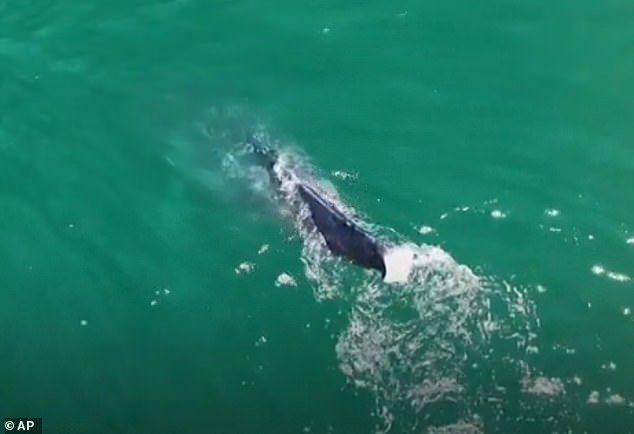Marine wildlife researchers recently made a heartbreaking discovery when they spotted a humpback whale in the ocean near Washington state.
The mammal had a devastating problem -its tail was missing.
The dramatic overhead drone video shot on July 23 shows the whale swimming, and for a second, everything looks normal. That is, until the massive sea creature dives under the water, revealing its severed appendage.
The iconic flukes on their tails are the main way they propel themselves through the water, prompting major worry among experts.
John Calambokidis, a research biologist with Cascadia Research Collective, told the Associated Press that it’s unlikely a humpback would survive long without its flukes.
When the whale dives, it becomes much more clear that it’s missing its flukes, which are crucial for propelling the mammal through the water
Jessica Farrer, research director with The Whale Museum on Washington’s San Juan Island, was among a team of scientists who responded to the sighting of the whale in late July.
The whale was initially spotted in the Salish Sea, the inland waters between Washington and British Columbia.
But since then, there hasn’t been another sighting, Farrer said.
‘Everybody has an emotion when they witness a humpback whale dive, and you see those massive flukes that are over 15 feet across, and here’s this whale, it’s just lost that. It’s like us losing our legs,’ Farrer said.
Farrer, along with the many experts that have reviewed the photos of the whale, agree that it lost its flukes due to entanglement.
The humpback could have gotten stuck in mooring lines, pots or nets, according to NOAA Fisheries.
The agency also says entangled marine life could get struck by boats while they’re immobile.
This aerial photo provided by The Whale Museum was taken near an island off the coast of Washington state on July 23, 2024. It shows a humpback whale that is missing its tail
The tailless humpback is seen spouting through its blowhole, the process through which it exhales water vapor
‘There are so many entanglement hazards floating around the world’s oceans. Old fishing gear that has broken free from fishing vessels or the gear that they leave behind,’ Farrer said.
‘And these whales have to swim through that and humpback whales are at an increased risk because they have those very long pectoral flippers.’
Farrer’s main concern for the tailless whale is that it won’t be able to swim fast enough to catch up with smaller fish so that it can feed itself.
Statistics from NOAA Fisheries show there were 16 confirmed humpback entanglements off the coasts of Washington, Oregon and California last year.
The year 2016 was a particularly bad one for humpback entanglements, topping a total of 40.
This was likely due to the Dungeness crab fishing season in California that year, which could have meant a lot more fishing gear for whales to try to navigate through, AP reported.
California has since changed the way it regulates commercial Dungeness crab fisheries in an attempt to protect animals from entanglement.
Justin Viezbicke, a whale entanglement responder with NOAA Fisheries, said there are sightings of whales along the west coast without flukes approximately every year or two.
This is how humpback whale’s tail usually looks. The flukes can be as wide as 15 feet from tip to tip
He added this anecdotal estimate is likely to vastly undercount the true number of whales who have lost their tails thanks to human intervention.
Calambokidis also said there are probably more whales without tails than are ever reported.
Still, he said humpback whale populations on the west coast are increasing and thriving despite the myriad of hazards.
Farrer hopes the shocking images of this severely injured humpback will be a wakeup call and lead to even more stringent protection efforts.
‘It’s one thing to show pictures of whales that are entangled or to talk about whales that have died from entanglements or see entanglement scars, but this whale swimming in the Salish sea completely without a tail is the poster child for the hazards that they’re facing.’
